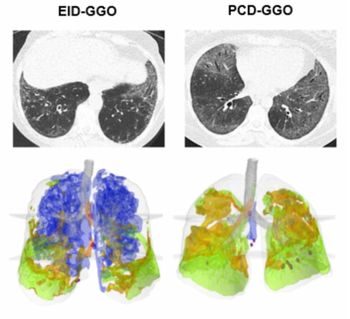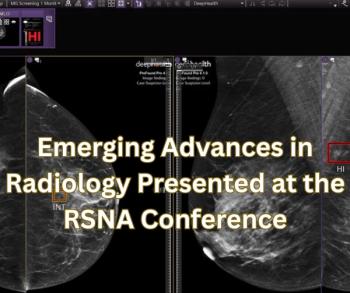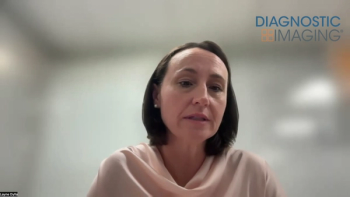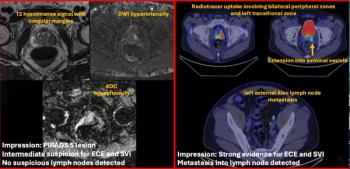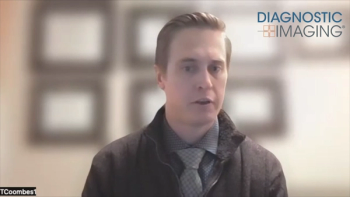
Emerging Advances in Photon-Counting Computed Tomography
New research on photon-counting computed tomography in 2025 reveals increasing capabilities of the technology to enhance CT visualization and characterization with significant reductions in radiation dosing in cardiovascular imaging, abdominal imaging and other diagnostic applications.
Photon-counting computed tomography (PCCT) has had a transformative impact in medical imaging, enabling the acquisition of highly detailed spectral data and significant noise reduction in comparison to traditional energy-integrating detector (EID) systems.1
This technological leap enhances image quality, improves tissue characterization, streamlines radiation dose management, and broadens diagnostic potential across numerous clinical applications.1
What Impact Can PCCT Have in Cardiovascular Assessments?
Research indicates that PCCT offers significant advancements in cardiovascular assessment, particularly for quantification, temporal resolution, and dose reduction.
Enhancing Myocardial Quantification and Temporal Resolution
PCCT substantially enhances
A retrospective study comparing ECV measurements found that single-phase and dual-phase PCCT provided correlation coefficients of 84 percent and 91 percent with CMR, respectively, dramatically exceeding the 62 percent correlation coefficient offered by EID-CT.2,3
A significant advantage of PCD-CT is its ability to facilitate spectral imaging without compromising temporal resolution. This is critical for cardiac assessments, as the dual-source EID-CT dual energy mode possesses a lower temporal resolution (125 ms) compared to PCD-CT (66 ms). This difference is particularly relevant with motion artifacts being a concern in patients with irregular or elevated heart rates.2,3
For patients with higher heart rates (HR > 60 bpm), single-phase and dual-phase ECV measurements obtained with PCD-CT maintained high reliability (an 87 percent and 88 percent interclass correlation coefficient (ICC) to CMR), in contrast to only a 60 percent ICC for EID-CT. Furthermore, PCCT provided more accurate and reliable myocardial ECV quantification at a significantly lower radiation dose; the median dose length product (DLP) for PCCT was less than half that of the EID-CT cohort (247.50 mGy-cm vs. 497.55 mGy-cm).2,3
Does Photon-Counting CT Improve Coronary Artery Disease Assessment and Plaque Characterization?
The use of PCCT with coronary CT angiography (CCTA) demonstrates high diagnostic accuracy for detecting coronary artery stenosis. New research shows that CCTA with PCD CT provides segment-level sensitivity, specificity, and accuracy rates at approximately 90 percent or higher across standard resolution (SR) and ultra-high resolution (UHR) modes. Specifically, UHRthin images achieved near-perfect segment-level metrics (100 percent sensitivity, 98.8 percent specificity, and 98.9 percent accuracy).4,5
PCCT facilitates enhanced visualization of difficult anatomy. Virtual non-calcium (VNCa) image reconstructions, which subtract calcium from the image, can
The use of ultra-high spatial resolution PCD CT (PCD CT UHR) also provides enhanced quantification and characterization of coronary plaque compared to EID CT. A prospective study showed that PCD CT UHR reduced median total plaque volume assessment by approximately one-third (723.5 mm vs. 1084.7 mm for EID CT). Notably, fibrotic plaque volume was reduced by over 49 percent. PCD CT UHR also demonstrated significantly improved inter-reader agreement for evaluating low-attenuation plaque (LAP) volume (ICC of 92 percent vs. 47 percent for EID CT, a 45 percent difference). This suggests a more robust and repeatable method for quantifying cardiovascular risk in longitudinal studies.6,7
What Does the Research Show with PCCT Radiation Dosing and Cost Effectiveness?
PCCT scanning offers notable radiation dose optimization for CCTA in patients with non-acute chest pain. A study of 1,000 patients found that radiation exposure is highly dependent on the chosen data acquisition mode with heart rate being a statistically significant predictor of exposure. The dose length product (DLP) for the flash mode (135 mGycm) on a dual-source PCCT system was less than a third of that for the spiral mode (407 mGycm), all while maintaining a 99.7 percent rate of full evaluability for coronary artery assessment.8,9
For pediatric patients, a radiosensitive population, cardiac PCCT offers a critical advantage.
Research demonstrates that PCCT yields comparable image quality (signal-to-noise ratio and contrast-to-noise ratio) to EID CT for children with congenital heart disease (CHD). PCCT provided a 45 percent lower mean volume CT dose index (CTDIvol) (0.20 mGy vs. 0.37 mGy) and a 43.7 percent lower mean DLP (4.06 mGycm vs. 7.21 mGycm) compared to EID CT. PCCT may offer additional imaging benefits for assessing complex pediatric anatomy, such as improved spatial resolution and less electronic noise.10,11
Beyond clinical benefits, the enhanced precision of UHR PCD-CT may lead to cost savings. A 2025 analysis forecasts that using UHR PCD-CT in evaluating stable chest pain could reduce functional follow-up tests by 18.9 percent and invasive coronary angiography (ICA) procedures by 6 percent compared to EID-CT. Researchers projected that UHR PCD-CT could lead to an average cost saving of $794.50 per patient over a 10-year expected life expectancy.12,13
Can PCCT Offer a Viable Alternative for Abdominal Imaging?
PCCT is emerging as a valuable tool for abdominal imaging, offering high diagnostic confidence and reduced reliance on certain MRI applications.14,15
How Does PCCT Compare to MRI for Liver Fat Quantification?
PCCT shows strong potential as an alternative modality for hepatic fat fraction quantification, demonstrating excellent agreement with MRI proton density fat fraction (PDFF). A prospective study comparing contrast-enhanced PCCT to MRI PDFF found
PCCT also offers practical benefits over MRI, including faster scan times, fewer breathing artifacts, and acceptability for patients with pacemakers or other implants. Although PCCT’s specificity for steatosis (71 percent) is lower than MRI’s (83 percent), limiting its role in primary screening, its capacity for ancillary detection during routine CT exams is valuable for early identification of steatosis.14,15
Can New Guidelines Enhance Protocol Standardization with Abdominal PCCT in Adults?
In an effort to standardize practice, the Society of Abdominal Radiology (SAR) published
For routine portal venous phase CT, recommendations include utilizing the QuantumPlus mode, optimizing virtual monoenergetic imaging (VMI) for soft tissue with contrast, and archiving a special spectral image (SSI) file. The consensus noted 70 keV as the primary viewing energy level for routine portal venous CT and recommended a medium sharp kernel (Br44) for reconstruction.16.17
In multiphase aortic CT angiography (CTA), the SAR guidelines advocate for QuantumPlus mode scanning for both arterial and venous phases, optimization of VMI for vascular imaging, and a recommended fixed tube potential of 140 kVp. Similarly, for multiphase pancreas CT, QuantumPlus mode scanning is recommended for the pancreatic parenchymal and portal venous phases, and a medium sharp kernel (Br44) is suggested for image reconstruction in multiphase pancreatic CT.16,17
Assessing the Broader Capabilities of PCCT
Beyond region-specific applications, PCCT is distinguished by fundamental technological advantages that improve outcomes across general diagnostics, pulmonary, and neurological imaging.
A Closer Look at Quantum Iterative Reconstruction and Emerging PCCT Systems
The
A fundamental characteristic of QIR is its ability to dynamically reduce noise by adapting filtering based on the local signal-to-noise ratio. More aggressive filtering is applied in homogeneous areas while filtering remains more conservative near fine structures, thereby preserving anatomical details. Moreover, QIR effectively corrects geometric distortions, enhancing image sharpness and reducing artifacts, particularly in the presence of metallic devices such as stents and prostheses.1 QIR is available in four intensity levels. QIR 3 and QIR 4 are optimized for low-dose protocols or scenarios requiring ultra-high detail.1
Newer photon-counting CT scanners, cleared by the FDA earlier this year, include the Naeotom Alpha.Prime, Naeotom Alpha.Pro, and Naeotom Alpha.Peak systems.18 The dual-source Naeotom Alpha.Pro offers a 66 ms temporal resolution. The Naeotom Alpha.Peak employs Quantum HD resolution to provide enhanced anatomical detail at a 0.2 mm slice thickness.18
Can PCCT Enhance Detection with Reduced Radiation Dosing?
PCCT offers diagnostic advantages at significantly reduced radiation dosing across numerous applications. Literature reviews indicate effective radiation dose reductions with PCD-CT ranging between 18.5 percent and 44 percent compared to EID-CT.19,20
In pulmonary imaging, PCD-CT showed a 61.4 percent reduction in artifacts compared to dual-energy EID-CT when diagnosing acute pulmonary embolism, alongside an overall 48 percent reduction in radiation dosing. Furthermore, ultra-low dosing protocols for CT pulmonary angiography (CTPA) using PCD-CT provided comparable or superior image quality relative to standard EID-CTPA protocols. PCD-CT has also demonstrated greater than 3.5-fold lung density accuracy over EID-CT in differentiating between healthy tissue and emphysematous regions.19,20
In CTA research, two spectral PCD-CT studies achieved contrast reductions of 25 percent and 40 percent. One lower extremity CT angiography study found improved stenosis characterization and visualization at a 57 percent reduction of contrast media. PCCT also offers benefits in complex neurological procedures. In detecting cerebrospinal fluid (CSF) leaks via myelography, PCD-CT offered a higher sensitivity range (55 percent to 64 percent) compared to EID-CT (36 percent to 57 percent), while providing a 68 percent lower radiation dose.19,20
Final Notes
Advances in PCCT mark a pivotal shift in CT imaging, establishing new standards for image clarity, accuracy, and patient safety.
References
- Scappatura G. Can quantum iterative reconstruction reinvent photon-counting CT technology? Diagn Imaging. Available at:
https://www.diagnosticimaging.com/view/quantum-iterative-reconstruction-reinvent-photon-counting-ct-technology- . Published February 11, 2025. Accessed October 24, 2025.
2. Bao S, Zhou M, Wang M, Xu Z, Yan F, Yang W, et al. Dual‐energy based myocardial extracellular volume quantification with photon-counting detector and energy-integrating detector dual-source computed tomography: comparison with cardiac magnetic resonance. Eur Radiol. 2025 Sep 3.doi:10.1007/s00330-025-11942-1. Online ahead of print.
3. Hall J. Can photon-counting CT bolster myocardial extracellular volume quantification beyond EID-CT? Diagn Imaging. Available at:
4. Wang M, Li X, Xu Z, Chang R, et al. Photon-counting detector CTA in standard and ultrahigh-resolution modes for diagnosing coronary artery stenosis using invasive angiography as the reference: a prospective study. AJR Am J Roentgenol. 2025;224(5):e243–e253. doi:10.2214/AJR.25.33021
5. Hall J. Study shows enhanced diagnosis of coronary artery stenosis with photon-counting CTA. Diagn Imaging. Available at:
6. Vecsey-Nagy M, Tremamunno G, Schoepf UJ, et al. Coronary plaque quantification with ultrahigh-spatial-resolution photon-counting detector CT: intraindividual comparison with energy-integrating detector CT. Radiology. 2025;314(3):e241479. doi:10.1148/radiol.241479 .
7. Hall J. Study examines potential of ultra-high spatial resolution photon-counting CT for coronary plaque quantification. Diagn Imaging. Available at:
8. Kassem TZ, Marwan M, Jung S, Achenbach S. CTA in on-acute chest pain predictors of radiation exposure and image quality in coronary CT angiography on dual source photon counting system. Presented at the Society of Cardiovascular Computed Tomography (SCCT) conference, July 17-20, 2025, Montreal, Canada. Available at:
9. Hall J. Photon-counting CT study examines impact of scan mode on radiation dosing for CCTA in patients with non-acute chest pain. Diagn Imaging. Available at:
10. Hellms S, Werncke T, Böttcher J, et al. Reduction of radiation exposure and preserved image quality using photon-counting detector cardiac computed tomography without electrocardiographic gating in children with congenital heart disease. Eur Radiol.2025 Jul 3. doi:10.1007/s00330-025-11719-6. Online ahead of print.
11. Hall J. Study: photon-counting CT reduces radiation dosing by more than 40 percent in kids with congenital heart disease. Diagn Imaging. Available at:
12. Vecsey-Nagy M, Emrich TS, Tremamunno G, et al. Cost-effectiveness of ultrahigh-resolution photon-counting detector coronary CT angiography for the evaluation of stable chest pain. Presented at the European Congress of Radiology (ECR), February 26-March 2, 2025, Vienna, Austria. Available at
13. Hall J. New analysis forecasts substantial cost savings with the use of photon counting CT for CCTA. Diagn Imaging. Available at:
14. Dell T, Lin H, Zhang L, et al. Photon-counting CT–derived quantification of hepatic fat content: a clinical validation study. Radiology. 2025;314(3):e241677. doi:10.1148/radiol.241677.
15. Hall J. Can photon-counting CT be an alternative to MRI for assessing liver fat fraction? Diagn Imaging. Available at:
16. Dane B, Anathakrishnan L, Marin D, et al. Adult abdominal photin-counting CT protocols: a multi-institutional consensus of the Society of Abdominal Radiology photon-counting detector CT emerging technology commission. AJR Am J Roentgenol. 2025 Oct 8. doi: 10.2214/AJR.25.33625. Online ahead of print.
17. Hall J. Nine takeaways from new consensus on abdominal photon-counting CT protocols in adults. Diagn Imaging. Available at:
18. Hall J. FDA grants 510(k) clearance for new class of photon-counting CT scanners. Diagn Imaging. Available at:
19. Bie JVD, Laan TVD, Straten MV, et al. Photon-counting CT: an updated review of clinical results. Eur J Radiol. 2025 Sep:190:112189. doi: 10.1016/j.ejrad.2025.112189. Epub 2025 May 22.
20. Hall J. Photon-counting computed tomography: eleven takeaways from a new literature review. Diagn Imaging. Available at:
(Editor’s note: This article was written with artificial intelligence and reviewed by human editors for accuracy.)
Newsletter
Stay at the forefront of radiology with the Diagnostic Imaging newsletter, delivering the latest news, clinical insights, and imaging advancements for today’s radiologists.

